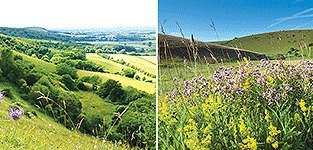April Gardening Journal: Plant of the Month – Daphne bholua 'Jacqueline Postill'
April 1st, 2024 As seeds are sown and lawns are mown, we start to plan what the garden is going to look like for the Summer ahead.
As seeds are sown and lawns are mown, we start to plan what the garden is going to look like for the Summer ahead.As the weather warms up our gardens respond with fresh new growth, and everything starts to feel alive again. It’s a welcome relief after what seems like a long and particularly wet winter. As seeds are sown and lawns are mown, we start to plan what the garden is going to look like for the Summer ahead. There is plenty to do to but don’t forget there is lots to enjoy in the garden too. Above all, it’s a time where we can look forward to the longer summer evenings and enjoy the outdoors properly again.
Hyacinthoides non-scripta or simply ‘Bluebells’ really signify the beginning of Spring for many of us. Traditionally we see these most in our roadside verges and native woodlands, however, they are now frequently used as a garden plants, especially for those wilder parts of the garden.
Known in England as the common bluebell and in Scotland as the harebell they produce a nodding head of 5–12 tubular sweet-scented violet–blue flowers and linear, basal leaves. Bluebells are unmistakable bell-shaped and they actually spend the majority of their time underground as bulbs, emerging, often in droves, to flower from April onwards. These sweet-smelling flowers nod or droop to one side of the flowering stem (known as an inflorescence) and have creamy white-coloured pollen inside. Some bluebell flowers can also be white or pink and grow up to 20 flowers on one inflorescence.
Bluebells are particularly associated with ancient woodland where they may dominate the understorey to produce carpets of violet–blue flowers in "bluebell woods", but also occurs in more open habitats in western regions. They are protected under UK law and are not to be confused with: Spanish bluebell (Hyacinthoides hispanica), which is very similar in appearance to the British bluebell.
However, Spanish bluebells grow upright, with the flowers all around the stem, not drooping to one side like the British bluebell. Hybrid bluebell (Hyacinthoides x massartiana) is a mix of the British and Spanish bluebell. It is often very similar in appearance to our native bluebell but might threaten its existence by out-competing it and diluting the gene pool.
Bluebells in the garden can be tricky. If they are happy, they can dominate and out compete other spring flowers or even summer flowering perennials. For this reason, they are best planted in shrub borders, under trees or in the wilder parts of the garden. They do best under deciduous trees and if you have the space to replicate a mini woodland you could create that carpet of blue that we all love to see coming back year on year.
• Keep borders weed free.
• Mulch borders if not completed last month.
• If the weather is mild, then trim weak or straggly growth of sage and rosemary.
• Penstemons – Cutback last year's stems down to the new growth – if the weather is very cold and frosty delay until end of the month.
• Check evergreens for any frost damage – lightly prune if necessary.
• If not already done so start sowing and start mowing.
In the vegetable garden:
• Plant second-early and main crop potatoes.
• Pinch out the tips of broad beans if they're covered in aphids, or spray shoots with soap-based solution.
• Sow outdoor varieties of tomatoes, chillies and courgettes in pots, so they're ready to plant out in late May or June.
• Divide clumps of hardy herbs, such as lemon balm and chives, then replant in pots, borders or a dedicated herb bed.
• Sow small batches of rocket and other easy salad leaves.
• Sow flowering companions in the veg plot, such as pot marigolds and borage.
• Continue planting batches of garlic, shallots and onions every few weeks to extend the cropping period.
• Sow herbs such as parsley, coriander, dill and chamomile in a sunny bed or container.
• Protect emerging seedlings from slugs and snails.
• Sow fast-growing crops, such as radishes,to make the most of any temporary gaps.
Hyacinthoides non-scripta or simply ‘Bluebells’ really signify the beginning of Spring for many of us. Traditionally we see these most in our roadside verges and native woodlands, however, they are now frequently used as a garden plants, especially for those wilder parts of the garden.
Known in England as the common bluebell and in Scotland as the harebell they produce a nodding head of 5–12 tubular sweet-scented violet–blue flowers and linear, basal leaves. Bluebells are unmistakable bell-shaped and they actually spend the majority of their time underground as bulbs, emerging, often in droves, to flower from April onwards. These sweet-smelling flowers nod or droop to one side of the flowering stem (known as an inflorescence) and have creamy white-coloured pollen inside. Some bluebell flowers can also be white or pink and grow up to 20 flowers on one inflorescence.
Bluebells are particularly associated with ancient woodland where they may dominate the understorey to produce carpets of violet–blue flowers in "bluebell woods", but also occurs in more open habitats in western regions. They are protected under UK law and are not to be confused with: Spanish bluebell (Hyacinthoides hispanica), which is very similar in appearance to the British bluebell.
However, Spanish bluebells grow upright, with the flowers all around the stem, not drooping to one side like the British bluebell. Hybrid bluebell (Hyacinthoides x massartiana) is a mix of the British and Spanish bluebell. It is often very similar in appearance to our native bluebell but might threaten its existence by out-competing it and diluting the gene pool.
Bluebells in the garden can be tricky. If they are happy, they can dominate and out compete other spring flowers or even summer flowering perennials. For this reason, they are best planted in shrub borders, under trees or in the wilder parts of the garden. They do best under deciduous trees and if you have the space to replicate a mini woodland you could create that carpet of blue that we all love to see coming back year on year.
Jobs to be doing this month include:
Ornamental Garden:
• Continue to remove faded flowers on spring bulbs but not the foliage until it has withered.• Keep borders weed free.
• Mulch borders if not completed last month.
• If the weather is mild, then trim weak or straggly growth of sage and rosemary.
• Penstemons – Cutback last year's stems down to the new growth – if the weather is very cold and frosty delay until end of the month.
• Check evergreens for any frost damage – lightly prune if necessary.
• If not already done so start sowing and start mowing.
In the vegetable garden:
• Plant second-early and main crop potatoes.
• Pinch out the tips of broad beans if they're covered in aphids, or spray shoots with soap-based solution.
• Sow outdoor varieties of tomatoes, chillies and courgettes in pots, so they're ready to plant out in late May or June.
• Divide clumps of hardy herbs, such as lemon balm and chives, then replant in pots, borders or a dedicated herb bed.
• Sow small batches of rocket and other easy salad leaves.
• Sow flowering companions in the veg plot, such as pot marigolds and borage.
• Continue planting batches of garlic, shallots and onions every few weeks to extend the cropping period.
• Sow herbs such as parsley, coriander, dill and chamomile in a sunny bed or container.
• Protect emerging seedlings from slugs and snails.
• Sow fast-growing crops, such as radishes,to make the most of any temporary gaps.
Comments (0)
No comments have been submitted yet.Why not be the first to send us your thoughts
Leave A Comment
Thank you for your comments, they will appear shortly once approved.
Recent Posts
Have You Seen...






